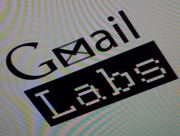 Our visit the other day to the GooglePlex was extraordinary on a number of levels. At its simplest, the Gmail group opened its kimono to bloggers and what’s left of the mainstream media – full stop. We were asked not to live video the announcements of Gmail Labs, and to clear photographs with the team in case we accidentally revealed some strategic details. But the tour of the Gmail team cubicles, the Google Reader unit, the spam guys, and the user testing facility was fascinating, particularly as it became clear how much was being done with a very small group of code warriors.
Our visit the other day to the GooglePlex was extraordinary on a number of levels. At its simplest, the Gmail group opened its kimono to bloggers and what’s left of the mainstream media – full stop. We were asked not to live video the announcements of Gmail Labs, and to clear photographs with the team in case we accidentally revealed some strategic details. But the tour of the Gmail team cubicles, the Google Reader unit, the spam guys, and the user testing facility was fascinating, particularly as it became clear how much was being done with a very small group of code warriors.
By contrast, when Jeff Raikes‘ replacement as president of the Microsoft Business Division, Stephen Elop, took over the unit encompassing Office, Dynamics CRM, and Unified Communications groups, ComputerWorld estimated he controlled at least 26,000 workers responsible for generating fully a third of Microsoft’s 2007 revenue. Certainly Gmail doesn’t represent all of Google’s Apps (Office) investment, but enough of it to make clear how devastating this nimble strike force is and how catastrophically it can undermine Office.
The “features” rolled out in Gmail Labs range from trivial to obvious, but the power is not in what Google engineers have produced on their 20% time initiative. Rather, it’s the feedback loop that results when users can recompile Gmail with a personalized addition of such features. First, they vote with their feet, sending signals to the team not just of what they pick but how long they use it, when they discard it, and what they pick next. It’s a million-plus user testing facility for free, an easy way of extending Google’s original strategy of scaling up as usage grows, and most importantly, a wedge for the viral Greasemonkey development community that the approach aims to stabilize.
Take the first 13 or so apps and throw them out; I like adding photos to chat and bookmarks to email yet probably don’t care if they go away. Now look at the functionality exposed in these sample tools: extending chat for example, which boasts in addition to Photos tools to hide status messages and add keyboard shortcuts to things like Focus chat contact search and the fascinating Focus last chat mole. Moles, by the way, are those little Gchat windows that open up and array intelligently at the bottom of the Gmail window or can be popped out to stand alone.
Let your mind wander a little and you can see how significant this granular control of the Gmail console can become. I asked product manager Keith Coleman whether a Labs feature could remember the position of chat moles once resized and placed outside the Gmail container. Add a focus pull to your favorite mole, say the Twitter XMPP gateway, and then use a version of status removal to filter Track messages. Well, you get the idea, and so did Keith. For free. From highly motivated Plan B users.
Of course, Google is not the only cloud that can take advantage of this iterative feedback loop. On Friday’s Gillmor Gang, I asked Google API lead (and former Hailstorm architect) Mark Lucovsky whether he agreed with many that Microsoft Live Mesh was just about replication of data, or like me, that it was the tip of a Titanic-sized iceberg. Factor in Coleman’s insistence that any third party API was fair game for inclusion in a Google engineer’s Gmail Labs feature, and that would by definition include Microsoft Mesh.
Coleman owns Google Reader and Gchat as part of Gmail Plus, so it seems likely that future services will tie in Apps, aid in constructing enterprise versions filtered around information aggregation, automated push services out along the XMPP bridge, and even developer tools that use the combined services to fashion bug-tracking, code generation, and collaborative project archives. Today, it’s a personalized recompiled Gmail; tomorrow, it will be extended to affinity groups around gesture-mandated dynamic builds that adjust based on behavior and proliferation of open standards.
Part of Google’s impetus to do this was to route around the instability of Greasemonkey scripts which stressed out the Javascript architecture with ad hoc strategies. But Greasemonkey will return with a vengence as soon as developers outside the company realize they can take off from these approved experiments and wire up external API’s. Quick Links, for example, could be extended with a TinyURL-like bridge to encapsulate FriendFeed conversations and export them to the Twitter or Mesh cloud, or be written into Google Reader’s new Shared Item Notes and broadcast to Gmail contacts under user control instead of the current “Friend” contact mining that damages GReader’s privacy integrity.
Inevitably, the combination of user feedback and behavior and external pirate Greasemonkey innovation will reach a boil. Ray Ozzie and Stephen Elop are on notice, and have their work cut out for them. As Lucovsky notes, Redmond is not just sitting idly by: check out Scott Guthrie’s description of Silverlight networking improvements such as Cross Domain Sockets and Background Thread Networking. But while Gmail may not have a third of Google’s revenue, they now have a hell of a lot more developers working for them than last week.